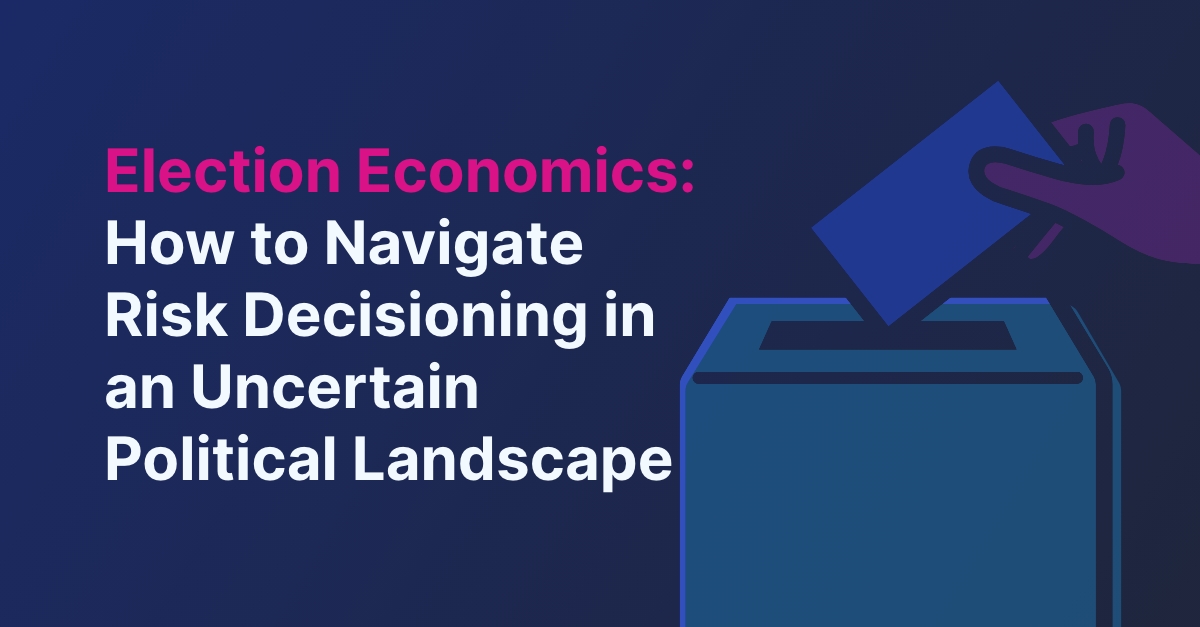Election Economics: How to Navigate Risk Decisioning in an Uncertain Political Landscape

Recent elections around the world have already triggered significant economic shifts, with far-reaching implications. In the UK General Elections in 2024, results have further shaped the ongoing Brexit process, influencing fiscal policies and regulatory frameworks that directly impact the financial industry. Uncertainty surrounding post-Brexit trade deals and regulatory realignment has already affected interest rates and inflation, creating tighter credit conditions for both consumers and businesses. And adjustments to the Bank of England’s interest rate policies or regulations governing financial institutions could further influence lending practices, with tighter borrowing conditions on the horizon for both individuals and small businesses.
In Argentina’s 2023 Presidential Election, a shift in leadership has brought about changes in economic strategy, particularly in the battle against soaring inflation. The new government’s attempts to control inflation and stabilize the economy are affecting the country’s monetary policy, leading to higher interest rates and tighter lending criteria. For financial institutions, this poses significant challenges, requiring lenders to quickly adjust their credit decisioning processes to accommodate economic instability. As inflation persists and the cost of borrowing rises, both consumer credit and business financing have become more difficult to secure, which further strains the economy.
The India General Elections earlier this year have also had effects on the fintech space. The results will influence regulatory policies surrounding fintech growth and digital finance, both of which are necessary for encouraging financial inclusion in underserved markets. Depending on the government’s support for these sectors, lending to traditionally underserved segments of the population could see either significant growth or stagnation. And changes in policy around digital finance could encourage new forms of lending, but they could also introduce more stringent regulations that will make access to credit much more challenging.
Of course top of mind these days, regardless of your location, is the upcoming US Presidential election. While it’s always something that has far-reaching effects, this year’s highly contentious ballot is poised to have sweeping global implications, on everything from global interest rates and inflation trends, to significant policy reforms on taxation, regulation, and lending practices. A key player in this process is the Federal Reserve, which closely monitors election outcomes and adjusts interest rates accordingly. If the newly-elected government pushes for changes in fiscal measures, the Federal Reserve’s response could shape borrowing costs, which in turn improves or challenges access to credit. For lenders and financial services providers, these shifts showcase how important it is to remain agile in the face of uncertain regulatory reforms and fluctuating market conditions. The global financial system will be watching closely as the election unfolds – because no matter who wins, there is bound to be significant changes that will reshape lending dynamics in the US and beyond.
Election outcomes can cause shifts in all sectors of the economy, but some areas in particular directly impact lending and risk decisioning. One of the most immediate effects is on interest rates, which are often adjusted based on fiscal policies introduced post-election. As interest rates fluctuate, lenders have to reassess risk profiles and adjust their credit and risk decisioning processes to account for any potential volatility in repayment abilities of their customers. Inflation control is also directly linked to post-election economic strategies. Any policies that either stimulate or dampen the economy can lead to varying levels of inflation – which affects everything from consumer purchasing power and household debt to business investments and the stock market. Inflation can also erode creditworthiness, with rising prices and an increased cost of living making it harder for both individuals and companies to manage their debt obligations. This means that lenders are then faced with the challenge of adjusting lending practices to maintain profitability while managing increasing risks in their customer base (which requires systems and solutions that enable flexibility in decisioning processes).
The outcome of any election also influences overall creditworthiness as economic conditions shift in response. Changes in the employment rate, business investments, interest rates, and fiscal stability all contribute to changes in credit and risk profiles. This is where a more dynamic approach to risk assessment is critical, with the ability to leverage intelligent, proactive risk decisioning solutions. Using advanced decisioning technology and data analytics allows financial services providers to adapt easily, identifying risks earlier and making more informed decisions. This proactive approach enables lenders to protect their profitability and lending portfolios while still serving the needs of customers effectively.
With elections comes uncertainty. And when there’s uncertainty, financial services providers need to proactively navigate shifting risk. Advanced risk decisioning solutions play a key role in helping you better predict (and respond to) risk, by leveraging real-time data and AI-driven analytics to identify emerging trends earlier and make smarter, faster risk decisions. Rather than simply reacting to sudden market fluctuations, proactive decisioning allows you to better predict future scenarios, preparing for possible fluctuations in interest rates, inflation, credit conditions, ability to repay, etc. Remaining agile and competitive is key to staying ahead of any uncertainty in the economy – election-driven or otherwise.
Holistic risk decisioning solutions also ensure a smoother onboarding process, with the ability to more accurately assess creditworthiness, even among rapidly changing market conditions. AI-powered decisioning software and solutions allows you to access and integrate vast amounts of data (everything from economic indicators and market trends to individual financial behavior), giving you a more accurate (and nuanced) view of a customer’s unique risk profile. Too often when economic conditions are volatile, the inclination is to be overly cautious. But that can stifle your business growth. With more proactive, agile decisioning, your lending portfolio remains stable (and profitable) even when external conditions aren’t.
Fraud prevention also becomes a key focus. During periods of political and economic uncertainty, fraud attempts often surge. With a holistic, data-driven approach to your risk decisioning, advanced algorithms and embedded intelligence can better detect unusual patterns and behaviors that signal fraudulent activity. Integrating fraud detection directly into the risk decisioning process allows you to greatly reduce losses, ensuring your operations remain secure, compliant, and resilient even among the unpredictability of major election upheaval.
Beyond onboarding, there is also the issue of managing ongoing customer relationships and maximizing value across the lifecycle. Ongoing account management is particularly important during periods of economic uncertainty. Advanced risk decisioning solutions empowers you to continuously, proactively monitor customer profiles and make adjustments easily. A flexible solution allows you to adjust credit limits and lending terms in real time as economic factors like inflation, interest rates, and consumer behavior evolve. Using AI-driven tools to track changes in individuals as well as broader market trends allows you to proactively mitigate risk, reducing the likelihood of defaults while maintaining a positive customer experience through personalized, flexible financial products and services.
Despite proactive, agile efforts to effectively manage your risk, post-election downturns are common, leading to increases in default rates and placing added pressure on collections and recovery strategies. Sophisticated (and more productive) collections treatment strategies are made possible with intelligent data and decisioning solutions. Leveraging advanced risk decisioning software allows you to segment delinquent accounts based on risk profiles, prioritize collections efforts, determine the best communications channels, and tailor recovery efforts to individual borrower profiles. Best of all, it allows you to anticipate defaults before they happen by closely analyzing customer behavior and economic trends to forecast likelihood of repayment, enabling you to approach debt recovery proactively and strategically. A more proactive approach not only helps to mitigate losses, but also supports a much more empathetic and effective recovery process, ensuring long-term management of your customer relationships.
Intelligent risk decisioning solutions are key to staying ahead of post-election shifts. By incorporating AI and advanced data analytics in one holistic platform, these decisioning solutions enable you to:
- Forecast and proactively mitigate potential risks
- Make data-driven lending decisions
- Improve onboarding processes
- Reduce customer friction
- Manage customer risks and relationships across the lifecycle
- Detect and prevent fraud
- Prioritize collections efforts
- Adjust lending practices with ease
- Continuously monitor the economic environment
Financial services providers that adopt forward-looking, proactive strategies (and which are armed with the right technology) will prove more resilient, positioning themselves for sustainable growth even in the face of political and economic change. Are you ready?
Discover how Provenir’s single decisioning platform offers you stability across the customer lifecycle.

Blog: The Growing Th...

Blog: Election Econo...
